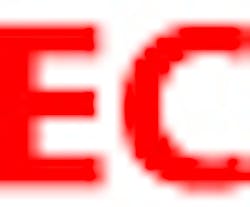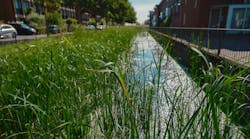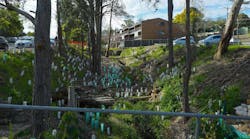As much as I have come to rue the prospects of airline travel lately—only once in my last five trips have I actually completed my itinerary as booked—I genuinely believe that participating in conferences and expositions is of great value, though that value is not always apparent at the time. I go with the expectation of learning new things about processes, practices, and techniques, but increasingly I’ve found that the greatest rewards lie not in the substantive aspects of the trade and its tricks, but in exposure to their broader issues and implications. It isn’t necessarily the direct import of the subject matter, but the dialog it raises with others as well as inside myself.
Recently I attended a presentation hailed in the program as an assessment of bioengineering techniques for achieving streambank stabilization. Expecting to hear details on geomorphology, materials, and structures, I was surprised when the presenter blasted off into the realm of philosophy, grounding his talk in the arena of “Harmony.” I use the term disturbed to describe my receptive state at that moment, particularly since I found myself in a silent debate with him and what I thought to be his overly messianic message. Eventually he got down to cases, and I soon dismissed the earlier episode from my mind.
Not until the next day, sitting at the airport awaiting a flight doomed to cancellation, did I recall the presentation, not for its anecdotal facets—not even for the presenter’s views on “Harmony”—but for the debate it raised within me and a synthesis in my own understandings as a result. I won’t suggest that anything earth-shaking transpired in that little episode, but I gained a measure of insight from that encounter that will help me do my job and that more than makes up for the expense and inconvenience of the trip.
A Case in Point
IECA’s 32nd Annual Conference & Expo, titled “Unearth a World of Opportunities,” will be held February 5-9, 2001, in Las Vegas. It will feature training courses, general sessions, technical sessions, workshops, forums, poster presentations, and numerous buying opportunities on the exposition floor. This year’s event promises to be the best ever and a must for those wanting to know what’s in store as the result of new and recent regulations on air and water quality. There are five separate tracks offering specific training to contractors, designers, regulators, and those involved in international and alternative pursuits.
The first two days of the conference are dedicated to full-day training courses that teach specific ESC topics offering continuing education units that may be applied toward CPESC certification. Included in the curriculum are the course and exam for those seeking their CPESC certification. Three days of training workshops describing and demonstrating real-world applications of ESC practices and technologies round out the educational portion of the expo. IECA’s innovative forum series employs a think-tank setting that offers a structured opportunity for meeting and interacting with industry professionals representing a wide area of expertise. Under the guidance of a facilitator, experts and attendees take responsibility for the development of the content and outcome, based on their needs.
Often you find people trivializing the value of the trade show portion of the expo, downplaying the commercial aspects of the industry in comparison with the educational opportunities and benefits of the event. This year more than 100 exhibitors will be displaying a full range of the latest products and services for the EC industry, much of which is new and will be shown for the first time. Not only is it the best—and in some respects the only—opportunity to see, touch, or even operate practices you might only have heard about, the displays are also the best place to interact with the exhibitors. Clearly a major challenge we face is lowering unit costs of ESC practices in order to expand their usage, and it occurs to me that one of the greatest values of an expo is found in the give-and-take between suppliers and users where expectations and real-world experience meet face to face. It is the best opportunity for all of us to guarantee that product and service development is a two-way street.


